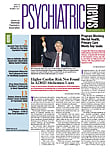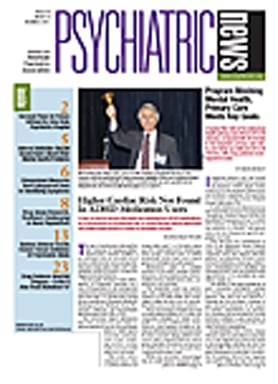Dimensional symptom measures, such as those being proposed for use in DSM-5, reveal a more complex symptom profile for patients with serious mental illness than do categorical diagnoses, said William Narrow, M.D., M.P.H., associate director of APA’s Division of Research, during the session “Clinical Complexity of Publicly Insured Patients and Implications for Clinical Practice” at APA’s 2011 Institute on Psychiatric Services in San Francisco in October.
Narrow presented an analysis of data from a study by the American Psychiatric Institute for Research and Education in which rates of categorical diagnoses and dimensional symptom ratings were examined for Medicare/Medicaid dual-eligible patients with schizophrenia, major depressive disorder, posttraumatic stress disorder, or substance use disorders.
“Compared with DSM-IV categorical measures, dimensional symptom measures resulted in a more clinically complex characterization of patients’ psychopathology, identifying many different symptom-based subgroups within each major diagnostic group,” Narrow said (see Key Points).
Data used for the analysis were collected from a practice-based research study of the Medicare Part D program in 2006. Clinically active psychiatrists were randomly selected from the AMA Masterfile and reported data on one systematically selected Medicare/Medicaid dual-eligible patient; data were obtained on 2,941 patients.
Detailed patient sociodemographic and clinical data were collected, including all DSM-IV-TR Axis I and II disorders, along with dimensional ratings of problems with psychotic, depressive, anxiety, manic, substance use, and sleep symptoms. Problems were rated as “none,” “mild,” “moderate,” or “severe.”
For each of the major diagnostic groups—schizophrenia, major depressive disorder, posttraumatic stress disorder, and substance use disorders—the dimensional ratings revealed significant comorbidity that was not captured by the DSM-IV categorical diagnoses.
For instance, among patients with schizophrenia, 10 percent had anxiety symptoms that were rated as “severe,” and 73 percent had symptoms of anxiety that were either “mild” or “moderate.” Yet only 6 percent had received any diagnosis of an anxiety disorder.
Similarly, 66 percent of patients with schizophrenia had problems with sleep— of whom 7 percent had symptoms that were rated as severe.
The same pattern was seen for major depressive disorder, posttraumatic stress disorder, and substance use disorders, with depressive, anxiety, and sleep problems reported at high rates across disorders.
Most strikingly, sleep disturbances were reported across all of the major diagnostic groups, but were never diagnosed in this patient group using a DSM-IV diagnosis. Eighty-eight percent of patients with major depression, 93 percent of patients with posttraumatic stress disorder, and 80 percent of patients with substance use disorders reported mild to severe sleep problems.
Narrow noted that cross-cutting dimensional measures of psychopathology, in symptom domains such as those used in the analysis, have been proposed for DSM-5 along with severity measures, specific to a diagnosis, that would be completed by clinician or patient.
“Clinicians should be alert to the presence of co-occurring symptoms in their patients,” Narrow said. “Dimensional measures have potential value in assessing patients’ clinical status and making and justifying treatment decisions, beyond information conveyed by a categorical diagnosis.”
Key Points
Dimensional measures uncovered significant comorbidity among public patients with serious mental illness that was not captured by categorical diagnoses.
Among patients with schizophrenia, 10 percent had anxiety symptoms that were rated as “severe,” and 73 percent had symptoms of anxiety that were either “mild” or “moderate.” Yet only 6 percent had received a diagnosis of anxiety disorder.
Depressive, anxiety, and sleep problems were reported at high rates across disorders. Eighty-eight percent of patients with major depression, 93 percent of patients with PTSD, and 80 percent of patients with substance use disorders reported mild to severe sleep problems though a sleep disorder was never diagnosed using DSM-IV categories.

